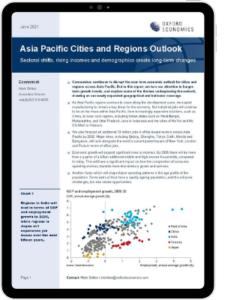APAC Cities Outlook | Sectoral shifts, rising incomes and demographics create long-term changes

Over the past twenty years parts of Asia Pacific have experienced some of the fastest economic growth globally. This trend is set to continue over the next fifteen years, with China and India continuing to lead Asia’s contribution to world GDP. In our latest APAC Cities and Regions Outlook, we explore some of the themes underpinning the outlook.
What you will learn:
- Sectoral shifts: As China transitions towards higher value, less labour-intensive manufacturing, there are opportunities for other lower wage Asian regions to take its place. We believe India and Indonesia are set to become Asia’s new industrial powerhouses.
- Rising income: Long-term economic growth will support rising incomes, helping millions of households move out of poverty and up through the income bands. Across the Asia Pacific region, there will be over 210 million additional middle-income households by 2035 compared to 2020.
- Ageing population: Ageing populations will pose challenges such as rising pension and healthcare costs, there will also be significant opportunities associated with the rise of the “silver economy”
If you would like to get access to our forecasts for 47 cities and sub regions in Asia Pacific, click here to submit a free trial request.

Tags:
Related Services

Post
House prices continue to slide for China’s cities
Research Briefing APAC Cities Outlook | Sectoral shifts, rising incomes and demographics create long-term changes While the property market downturn has been universal, the scale and depth has been varied for different cities and regions.
Find Out More
Post
The Construction Productivity Challenge in Australia
Delve into the state of construction productivity in Australia. Understand the factors affecting growth and how innovation can transform the industry for the better.
Find Out More